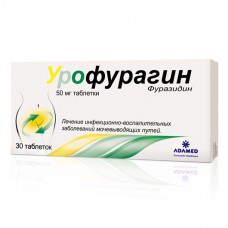Expiration date: 01/2026
Composition:
1 tab. furazidine 50 mg Excipients: corn starch - 27.5 mg, sucrose - 13.75 mg, colloidal anhydrous silicon dioxide - 1.25 mg, stearic acid - 7.5 mg.
Indications for use:
For oral administration: urogenital infections (acute cystitis, urethritis, pyelonephritis), gynecological infections, skin and soft tissue infections, severe infected burns, for preventive purposes during urological operations (including cystoscopy, catheterization). For external and local use: infectious and inflammatory diseases of the oral cavity and pharynx, infected wounds.
Dosage and administration:
Taken orally after meals. Adults - 50-100 mg 3 times / day, children older than 3 years - 25-50 mg (no more than 5 mg / kg of body weight) 3 times / day. The course of treatment is 7-10 days. If it is necessary to repeat the course of treatment, you should take a break for 10-15 days. For the prevention of infection (including during urological operations, cystoscopy, catheterization) - 50 mg once 30 minutes before the procedure. Apply externally 2-3 times / day for washing wounds or wetting the dressing material. Apply topically 2-3 times / day in the form of mouth and pharynx rinses.
Pharmacodynamics:
Antimicrobial agent of a wide spectrum of action, belongs to the group of nitrofurans. Under the influence of nitrofurans, the respiratory chain and the tricarboxylic acid cycle (Krebs cycle) are suppressed, as well as other biochemical processes of microorganisms are inhibited, as a result of which their shell or cytoplasmic membrane is destroyed. It is active against gram-positive cocci: Streptococcus spp., Staphylococcus spp., Gram-negative bacilli: Escherichia coli, Salmonella spp., Shigella spp., Proteus spp., Klebsiella spp., Enterobacter spp., protozoa: Lamblia intestinalis and other microorganisms resistant to antibiotics. Furazidine is more active against Staphylococcus spp., Escherichia coli, Aerobacter aerogenes, Bacterium citrovorum, Proteus mirabilis, Proteus morganii compared to other nitrofurans. For most bacteria, the bacteriostatic concentration ranges from 1:100,000 to 1:200,000. The bactericidal concentration is about 2 times higher. As a result of the action of nitrofurans, microorganisms emit fewer toxins, and therefore an improvement in the general condition of the patient is possible even before the pronounced suppression of the growth of microflora. Nitrofurans activate the body's immune system: they increase the complement titer and the ability of leukocytes to phagocyte microorganisms. Furazidine in therapeutic doses stimulates leukopoiesis. Resistance to furazidine develops slowly and does not reach a high degree.
Pharmacokinetics:
After oral administration, furazidine is absorbed from the small intestine by passive diffusion. The absorption of nitrofurans from the distal segment of the small intestine exceeds the absorption from the proximal and medial segments by 2 and 4 times, respectively (should be taken into account when simultaneously treating urogenital infections and gastrointestinal diseases, in particular chronic enteritis). Nitrofurans are poorly absorbed from the colon. Cmax in blood plasma persists from 3 to 7 or 8 hours, furazidine is detected in urine after 3-4 hours. Furazidine is distributed evenly in the body. Clinically important is the high content of the drug in the lymph (delays the spread of infection through the lymphatic pathways). In bile, its concentration is several times higher than in serum, and in liquor - several times lower than in serum. In saliva, the content of furazidine is 30% of its concentration in serum. The concentration of furazidine in blood and tissues is relatively small, which is due to its rapid release, while the concentration in urine is much higher than in blood. It is metabolized to a small extent (<,10%). It is excreted by the kidneys by glomerular filtration and tubular secretion (85%), partially undergoes reverse reabsorption in the tubules. At low concentrations of furazidine in the urine, the filtration and secretion process prevails, at high concentrations, secretion decreases and reabsorption increases. Furazidine, being a weak acid in acidic urine, does not dissociate, undergoes intensive reabsorption, which can increase the development of systemic side effects. With an alkaline reaction of urine, the excretion of furazidine increases. With a decrease in the excretory function of the kidneys, the intensity of metabolism increases.
Use during pregnancy and lactation:
It is contraindicated to use the drug during pregnancy and lactation (breastfeeding).
Use in cases of impaired renal function:
It is contraindicated in severe chronic renal failure.
Use in children:
Contraindicated in children under 3 years of age.


